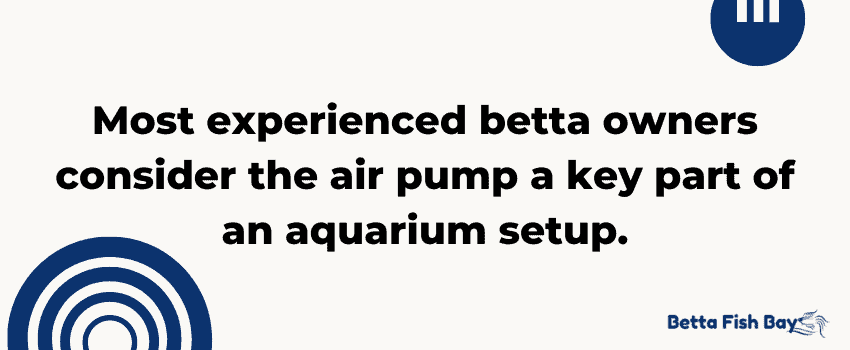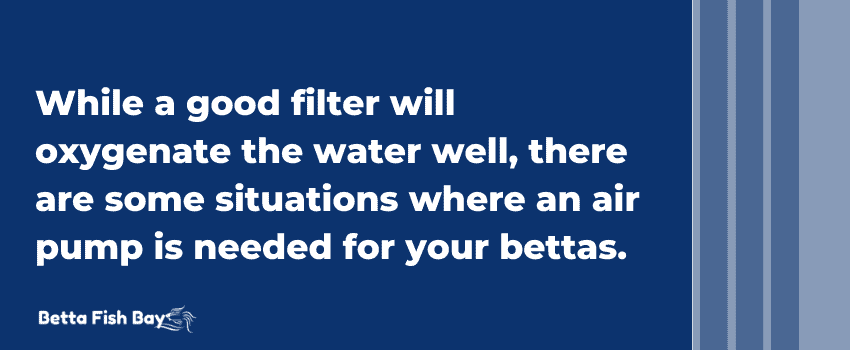Many betta owners turn to air pumps to help improve the quality of their tank water.
But there are almost as many who pass on it.
What’s the truth? Do betta fish need an air pump?
Betta fish do not usually need an air pump in their tank. But there are certain situations where an air pump would be beneficial. For example, if your betta is on medication removing oxygen from the water, it may benefit from an air pump. This device also promotes clean water, reducing instances of disease.

Table of Contents
Betta Fish Breathing and Oxygenation
Labyrinth Organ
Bettas are classified as labyrinth fish, which means they have a labyrinth organ. This organ is special because it allows bettas to breathe oxygen.
If you ever see your betta swimming to the top of the tank, it’s probably coming up for oxygen. Bettas have evolved to need oxygen access from time to time.
The labyrinth organ becomes larger when the betta lacks oxygen. It shrinks back down when the betta has received the oxygen it needs.
Oxygenation in the Aquarium
Since betta fish require oxygen, keeping your tank water oxygenating is crucial. Specifically, aim for oxygen levels of around 5 to 7 ppm (parts per million).
There are a few different factors affecting oxygen levels in your betta tank:
- Aquarium plants
- Water disturbance
- Aeration of water via bubblers or air pumps
Betta fish thrive in fresh, oxygen-rich water.
Air Pumps: Overview and Purpose

Air pumps play a key role in aquarium health.
What is an air pump?
An air pump is a device used to add oxygen to water. It does this by aerating the water and producing bubbles.
How do air pumps work?
Air pumps increase water movement throughout the tank. It does this by pushing water from the top toward the bottom and vice-versa.
This movement oxygenates the water, making it more suitable for labyrinth fish.
Additionally, air pumps produce bubbles in the water. While these bubbles don’t create much oxygen, they help with gaseous exchange.
Gaseous exchange is when fish breathe oxygen from the water and release nitrogen.
The Role of Air Pumps in Aquariums
Air pumps serve three main functions in an aquarium:
- Aeration: The primary role of air pumps is to help oxygenate the aquarium water. Doing so helps bettas get a more efficient gaseous exchange, allowing them to thrive.
- Circulation and surface agitation: Air pumps increase circulation and surface agitation. However, this isn’t necessarily crucial for your bettas, as they prefer still waters.
- Assistance to beneficial bacteria: The pump’s aeration also helps good bacteria thrive. When properly oxygenated, aquariums host beneficial bacteria. The bacteria help keep the water clean and high-quality.
Tank Setup and the Role of Filtration

To help your betta thrive, ensure you have the proper tank setup and filtration system in place.
Essential Equipment for Betta Fish Tanks
There are a few different components to include in your new betta tank.
Substrate: Place 1–2″ inches of substrate or gravel at the bottom of the tank. Opt for a neutral substrate, as bright colors might stress your betta.
Filter: Installing a low-flow filter in your betta tank is crucial. The filter will help circulate and clean the water. The low-flow design is essential for two reasons: 1) Bettas prefer still waters, and 2) more powerful filters may damage your betta’s fins.
Heater: An aquarium heater helps keep the water temperature within optimal parameters. Bettas are tropical fish, meaning they need warm water to thrive.
Lighting: Adequate lighting will help keep your betta’s sleep-wake cycle in check. It also helps live aquarium plants thrive. Opt for lighting systems which allow you to program specific time frames for light and dark.
Plants / Decor: Adding plants to your tank greatly increases oxygen and tannin levels. Betta fish prefer waters with plenty of plants, as it resembles their natural environments. There are numerous aquarium plants to consider including in your tank.
Lid: Betta fish are fantastic jumpers, and there are several reasons why they might jump out of the tank. Keep your betta fish healthy and safe by keeping a lid on the tank.
Filtration Systems
A good filtration system is critical to creating a healthy environment for your betta.
With an effective filter, you won’t even need the extra oxygen from an air pump. This is because filters take stagnant water and circulate it, helping to aerate the water.
Sponge Filter
This is a great option for smaller tanks under 40 gallons.
It works by removing particles from the water via a mechanical filter sponge.
This both cleans the water and allows good bacteria to grow on the sponge, improving water quality.
This is an affordable and efficient option, but you’ll need an air pump to operate it. Also, it’s not as powerful as other options.
Hang-on-back Filter
This filter type hangs on the back of the outside of your tank, making it easy to clean and maintain.
It works by pulling water into a tube, putting it through a cleaning media, and releasing it back into the tank.
Remember: this filter type is noisier than others, and its more powerful flow may not be ideal for bettas.
Internal Filter
An internal filter is attached to the inside wall of the tank via suction cups. This makes it difficult to clean and maintain, and it takes up a bit of tank space.
Internal filters feature mechanical, chemical, and biological filtering.
Additionally, it’s considered a quiet filter type, making it perfect for betta aquariums.
Corner Filter
Corner filters are a bit antiquated, but some betta owners still use them.
This filter type rests inside the aquarium, in the corner of the tank. It uses charcoal and aquarium filter floss to clean the water.
Its low flow rate makes it a great option for bettas, who prefer still waters.
Canister Filter
This type is best for larger tanks, usually 50+ gallons.
Canister filters work by filtering the water through a specific medium and releasing it back into the tank.
It sits beneath the aquarium, making it difficult to maintain. Also, this filter type is more expensive than others and has a powerful flow rate.
Under-gravel Filter
This filter type sits beneath the gravel or substrate of the tank.
While it offers good mechanical filtration, it tends to be less consistent and more difficult to clean than other types.
Balancing Filtration and Aeration

For the most part, if you have a good filter, you will not need extra aeration. This is because filters help to move the water around, oxygenating it.
This said, you may need to increase oxygen levels if any of these things are true:
- Your betta is on medication
- Your betta is gulping for air
- Your filter is clogged
- Your tank is overcrowded
Good Aeration Methods
There are several ways to create a more oxygenated environment for your betta:
- Live plants
- Water changes
- Air pumps
- Air stone
- Sponge filter
Water Agitation and Its Benefits
Water agitation plays many beneficial roles in aquarium environments.
The Role of Water Agitation in Maintaining Water Quality
Water agitation allows for oxygenation of the water, making it more habitable for your betta. It also prevents water stagnation, reducing toxin and bacteria buildup.
Surface Agitation and Gas Exchange
Since bettas need oxygen due to their labyrinth organ, surface movement is essential. It helps draw oxygen into the water, helping your betta stay healthy and happy.
Preventing Biofilm Formation
Biofilm formation is a common issue in stagnant water.
Biofilms are dangerous, causing antimicrobial resistance and helping harmful bacteria thrive. Keeping the water circulated can help reduce biofilm risk.
Reducing the Risk of Diseases
Avoiding biofilm and providing your betta with ample oxygen will help prevent disease. Many common betta diseases are preventable with proper betta care and environment.
Planted Betta Fish Tanks and Air Pump Considerations
If you have live plants, there are additional factors to consider.
Benefits of Live Plants in Betta Fish Tanks
Live plants are an excellent addition to any aquarium. They increase oxygen levels, decrease carbon dioxide levels, and promote good bacteria.
CO2 and Oxygen Balance in Planted Tanks
It’s essential to properly balance oxygen and carbon dioxide in your planted tank.
Plants rely on carbon dioxide for photosynthesis, which produces oxygen, so levels should never get too low.
The key is to give your plants ample carbon dioxide without flooding your tank with it.
Air Pump Usage in Planted Tanks
Since your plants will need carbon dioxide, ensure any air pump you use isn’t too strong. Too much oxygen will harm your plants.
Opt for an air pump with an adjustable output level. This will give you more control of oxygen vs. carbon dioxide levels.
Keep Your Bettas Healthy With Appropriate Oxygen Levels
An air pump is a useful device for increasing water circulation and oxygenation in tank water. This has numerous benefits, including the following:
- Less risk of betta disease
- Reduced harmful bacteria levels
- Healthier aquarium plants
Air pumps aren’t necessary for bettas, but they are useful in certain situations. For example, when your betta is on medication or your plants are yellowing.
Opt for a quiet air pump with your desired air volume. Also, determine which type (plug-in, battery-operated, or battery backup) you would prefer.
Keeping the tank water well-oxygenated is crucial to help your betta thrive.


